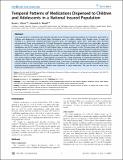Temporal Patterns of Medications Dispensed to Children and Adolescents in a National Insured Population
Author(s)
Olson, Karen L.; Mandl, Kenneth D.
DownloadOlson-2012-Temporal patterns of.pdf (839.3Kb)
PUBLISHER_CC
Publisher with Creative Commons License
Creative Commons Attribution
Terms of use
Metadata
Show full item recordAbstract
This study aimed to comprehensively describe prevalence and temporal dispensing patterns for medications prescribed to children and adolescents in the United States. Participants were 1.6 million children (49% female) under 18 years old enrolled in a nation-wide, employer-provided insurance plan. All medication claims from 1999–2006 were reviewed retrospectively. Drugs were assigned to 16 broad therapeutic categories. Effects of trend over time, seasonality, age and gender on overall and within category prevalence were examined. Results: Mean monthly prevalence for dispensed medications was 23.5% (range 19.4–27.5), with highest rates in winter and lowest in July. The age group with the highest prevalence was one-year-old children. On average each month, 17.1% of all children were dispensed a single drug and 6.4% were dispensed two or more. Over time, prevalence for two or more drugs did not change, but the proportion of children dispensed a single drug decreased (slope -.02%, p = .001). Overall, boys had higher monthly rates than girls (average difference 0.9%, p = .002). However, differences by gender were greatest during middle childhood, especially for respiratory and central nervous system agents. Contraceptives accounted for a large proportion of dispensed medication to older teenage girls. Rates for the drugs with the highest prevalence in this study were moderately correlated (average Pearson r.66) with those from a previously published national survey. Conclusion: On average, nearly one quarter of a population of insured children in the United States was dispensed medication each month. This rate decreased somewhat over time, primarily because proportionally fewer children were dispensed a single medication. The rate for two or more drugs dispensed simultaneously remained steady.
Date issued
2012-07Department
Harvard University--MIT Division of Health Sciences and TechnologyJournal
PLoS ONE
Publisher
Public Library of Science
Citation
Olson, Karen L., and Kenneth D. Mandl. “Temporal Patterns of Medications Dispensed to Children and Adolescents in a National Insured Population.” Ed. James G. Scott. PLoS ONE 7.7 (2012): e40991.
Version: Final published version
ISSN
1932-6203